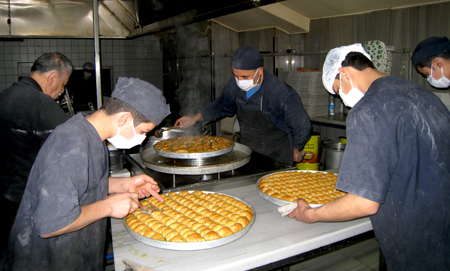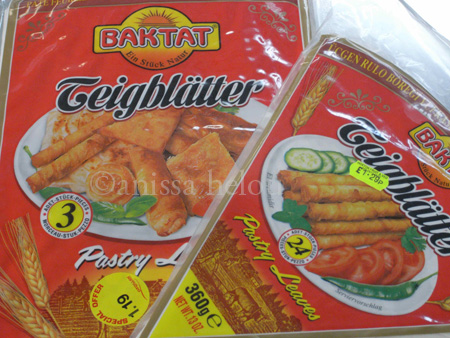11 Apr

Middle Easterners are famous for their sweet tooth and I am no exception. I may no longer like chocolate but I still love other sweets, in particular baklava, a generic term describing a range of pastries made with filo or ‘hair’ pastry and filled with nuts and sometimes kaymak (thick cream). However, despite my curiosity for all things culinary from when I was a child, I had never seen commercial baklava being made until I visited the kitchens of Gulluoglu in Istanbul with my dear friend, Nevin Halici, and those of Imam Cagdas in Gaziantep with another dear friend, Filiz Hosukoglu, where an army of sweet-makers were making everything by hand, from rolling the filo to filling and shaping the different types of baklava to drenching it in sugar syrup. And from the very beginning to the very end, the process is mesmerising. Here are some pictures I snapped in Imam Cagdas’ baklava kitchens where they bake the baklava in a wood-fired oven.
22 Dec
[vimeo]http://vimeo.com/33820980[/vimeo]
This may be the last of my yufka posts unless I find good clips and photographs from my visits to Gulluoglu and Imam Cagdas. Yufka for baklava is much thinner than that for regular or su boreks. Until then, you have to do with these clips I shot in a cafe where we had stopped not far from Safranbolu, a UNESCO world heritage site. It was lucky we arrived as the woman was rolling out yufka for su borek (possibly the most famous of all boreks, a meat or cheese pie that is baked whole then divided into square portions). The yufka for su borek is boiled before being used to make the pie, a little like lasagna, and I had been wanting to see the process from when I had read about it in Nevin Halici’s Turkish Cookbook, which by the way is totally brilliant.
18 Dec

So, I went to my local Turkish shop in Hoxton Street and bought some yufka and I have to say, it is not a patch on the one I had in my freezer which a friend had brought me from Gaziantep. What was interesting though is that even though the commercial yufka felt dry and coarse when I was working with it, it was absolutely fine to eat. Obviously not as good as the hand-made one but not a lot worse. In fact, both were pretty delicious with the commercial yufka being more crisp than the artisanal one. This said, I will be going back to using filo for my savoury pastries because I prefer the thinner, finer pastry. It is easier to make good shapes with it and if you buy Turkish filo (which is also called yufka but they use the thin sheets for sweets), it is even thinner than the Greek and way better than any supermarket brand.
15 Dec
[vimeo]http://vimeo.com/33222252[/vimeo]
It’s time for me to start travelling again. I have much more fun on my travels than when I am holed up in my loft, however gorgeous it is. And it is not in Shoreditch that I am going to push the door of a normal looking building to find rather good looking young men making yufka the way their fathers and grandfathers did before them. Or mothers and grandmothers as they would have done in earlier times. These guys were working on the ground floor of a regular building in Gaziantep in south eastern Turkey right next door to my favourite ice cream place, Ozgüler. I would have missed them if it wasn’t for the big sign advertising yufka. Unlike filo, yufka is slightly baked after being rolled out.
